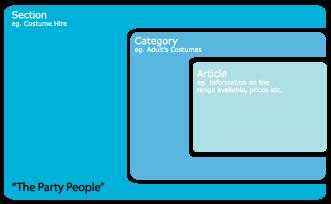The structure for organizing content within your Joomla! site is based on a hierarchy of Sections, Categories, and Articles.
Sections are created first and established as the highest level of organization, separating the content of the site into the broader topic areas. Categories are then created and allocated to Sections, to sort the content into more specific subject areas. Articles are allocated to Sections and Categories and present the details on these areas on the frontend of the website.

To access the individual manager screen for Sections, Categories, or Articles, use either the Control Panel icons, or go to Content | Section Manager | Category Manager | Article Manager from the menu.
Using the Section Manager as a guide, we can edit and manage all the Sections created for your site. Double clicking the name of the section provides access to the details.

Use the icons on the toolbar to create a new Section, delete an existing one, or publish/unpublish them.
The Category Manager and the Article Manager are accessed the same way.
Within the Party People website, there are five Sections, each with at least two Categories within them. Articles are then created and allocated to each depending on their content.
When your developer established your site, he/she would have created a Section and a Category for the content to be allocated. Chapter 2, Creating, Editing, and Organizing Content looks at this in a detailed manner when we create and allocate content to Sections and Categories.
Articles generally used for content that is not associated with any particular Section or Category are saved as uncategorized. They are content items that are used in certain locations, where the content remains the same and doesn't require user input or regular updates. Content that requires updating regularly and may include enabling a user to add comments is allocated to a category. For example, a "Welcome to the Site" message may be listed as a static item.



